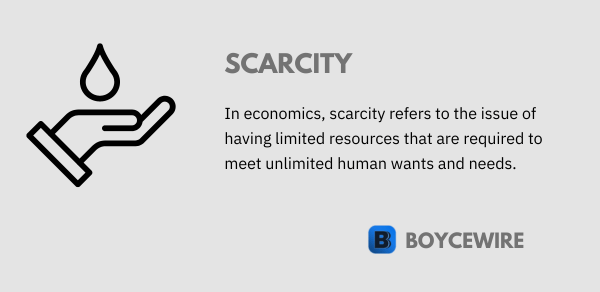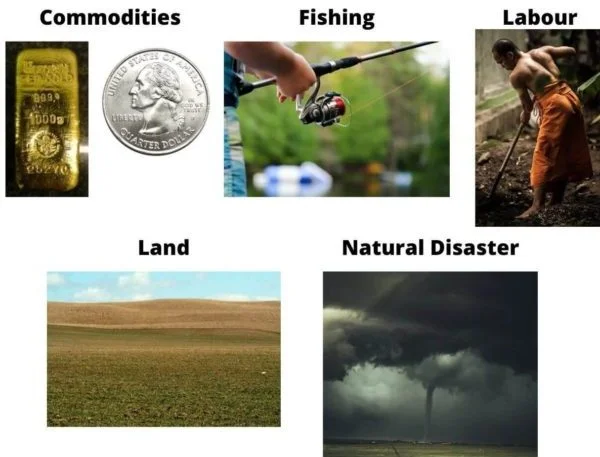Scarcity Definition

What is Scarcity in Economics?
In economics, scarcity refers to the limited resources we have. For example, this can come in the form of physical goods such as gold, oil, or land – or, it can come in the form of money, labour, and capital.
These limited resources have alternate uses. There are many ways to spend $50, but it can only be spent on one thing. A consumer with $50 in their pocket, they cannot buy both a pair of trainers AND a nice jumper. That is the very nature of scarcity – it limits human wants.
Key Points
- In economics, scarcity refers to limited resources which are required to meet the unlimited demand of humans.
- There are three causes of scarcity; demand-induced, supply-induced, and structural.
- There are also two types of scarcity; relative and absolute.
Scarcity Explained
Scarcity and economics go hand in hand – after all, economics is the study of the allocation of scarce resources. With that said, what is the importance of scarcity? Well, it means that people must make decisions on how to maximize their utility. In other words, consumers must decide on how best to use resources to gain maximum satisfaction.
As resources are scarce, we have to choose between options, which presents an opportunity cost. By choosing one over the other, we forego that option. This is the very nature of scarcity, as involves compromise. We cannot have both the latest PlayStation and Xbox when we only have $500 to spend. Decisions must be made when resources are scarce — based on the marginal utility of value.
In other words, consumers must decide on how best to use their resources, usually money, in order to maximise their utility. For instance, a customer goes into a store to buy a chocolate bar but only has $1. They face multiple brand choices – however, they only have enough money for one. In the face of scarce resources, they must choose what presents the most value to them. They must consider the fact that by buying one, they cannot have the other, so, therefore, will choose that good that brings them the highest utility.
Scarcity and Value
When we have scarce resources, we must decide how best to use them. However, this equally depends on the resources we buy. For instance, the scarcer a resource, the greater its value. If we look at diamonds, they are very rare and precious – it’s a scarce resource. At the same time, it is a resource that is highly demanded across the world which means that it is in high demand but also has a low and limited supply. In turn, this contributes to its high valuation across the world.
This valuation can be split down between consumer scarcity – the scarcity of our individual resources. We then have producer scarcity – the scarcity of the goods or services we are purchasing.
“Scarcity is based upon two factors: the scarcity of our own resources, and that of the resources we want to buy.”
If, for instance, a customer would like a bottle of water, their value is much higher if they cannot get another for miles around. To demonstrate, the value of water is much higher to a person stuck in the middle of the desert than in the comfort of their home. In short, the scarcity of the product can increase the value to the customer.
On its own, the scarcity of a resource increases an item’s value. This is because we, as consumers, place a higher value on it as a result.
The Diamond-Water Paradox
The diamond-water paradox was said to have originated from Adam Smith who posed the question in his book ‘The Wealth of Nations’. Smith questioned the price difference between water and diamonds. Why he posed, are diamonds valued so highly, yet water, which is a human necessity, valued so low.
The reason is that diamonds are valuable because of people’s subjective value. In other words, what people are willing to pay for it.

People are willing to pay more for diamonds, so they are naturally valued more highly. However, that still doesn’t explain why they are valued more highly than water. After all, we need water to survive.
There are several factors that contribute to this, but the two main variables are scarcity and marginal utility. Diamonds are naturally scarce, which gives it its value. By contrast, water is readily available almost anywhere in the developed world.
To explain, water is easy to access. We have more than enough to satisfy our immediate needs. Anything beyond our most crucial needs starts to lose value. For instance, after eating a large meal, the value placed on another drastically falls. The same principle applies to water.
It is because our very basic needs are met that we can place a greater value on luxuries such as diamonds.
Types of Scarcity
There are two types of scarcity, absolute, and relative. Let us first look at what relative scarcity is.
1. Relative Scarcity
Relative scarcity is where a good is naturally limited in supply. So, there is only a finite number available. However, we define relative scarcity as being naturally limited, but is also scarce relative to demand.

In other words, relative scarcity is where supply does not meet demand. But this is due to a limited supply of resources rather than a company’s inability to supply.
This should be seen in stark contrast to the shortage. For instance, a shortage occurs because of inefficient management or poor distribution. To demonstrate, there was a shortage of PS4 Pros in 2018. We would not say this is scarce, but rather Sony was unable to resource enough to meet demand. By contrast, relative scarcity is limited by nature.
2. Absolute Scarcity
Absolute scarcity is where the supply of a good is naturally limited. In other words, there is nothing humanly possible for us to increase supply. However, absolute scarcity is where the number of goods cannot diminish. For example, we have an absolute scarcity of 24 hours each day. This cannot be extended nor reduced.
In the same fashion as relative scarcity, demand cannot be met. However, absolute scarcity is scarce irrelevant to demand.
Causes of Scarcity
There are three main causes of scarcity. They are:
1. Demand Driven
Resources become scarce when demand increases faster than supply. As more people buy goods, there are fewer resources available to others. For instance, let us say there is a supply of 1 million barrels of oil delivered to the market – enough to meet demand. However, over the course of a year, demand increases to over 1.5m barrels.
As a result, oil becomes a relatively scarce resource, driven by the increase in demand. Oil itself is a scarce resource, but because of the new higher level of demand, it is relatively scarce. Producers are unable to meet the new demand, which creates a scarcity of resources in the short-term.
2. Supply Driven
When demand is constant, but supply declines, we have a supply-driven scarcity. However, this is created by limited resources. In other words, there is a dwindling supply that cannot be extended. For instance, the Japanese tsunami of 2011 destroyed hundreds of manufacturing plants which took out a significant source of supply to both domestic and international markets. Prices inevitably rose as the economy took the hit.
3. Structural
Structural scarcity occurs when a certain resource is scarce to a proportion of the population. In other words, there is unequal access to resources because of political issues or location. For example, people living in the suburbs may not have the same access to a doctor, and healthcare as someone living in a city. In addition, they may not have the same choice of schooling to send their kids.
Scarcity Examples
Every product or service is scarce in its own regard. For instance, there are not unlimited dentists. Appointments are limited. However, it is the number of qualified dentists that is scarce relative to demand.

1. Commodities
Goods like gold, oil, and other fossil fuels are naturally rare. However, when demand exceeds its supply, it becomes relatively scarce.
2. Fishing
When property rights are non- existent, waters can become overfished. Consequently, certain types of fish become scarce. At any one time, there are only a limited number of fish available. Therefore, the more the sea gets exploited, the scarcer the fishes become.
3. Labour
There are only so many people and so many hours they can work. By its very nature, this makes it a scarce resource. For example, we only have a certain number of trained doctors at any one time. Their services are therefore scarce in the fact that they can only see so many people per day.
4. Land
By its very nature, land is in limited supply. In fact, in some metropolitan areas, it is made artificially scarce due to strict land-use laws. For instance, land in New York is extraordinarily expensive. As more and more people move into the city, the availability of land also becomes scarcer.
5. Natural Disaster
Hurricanes, volcano eruptions, and flooding are all examples of natural disasters that can contribute to scarcity. For instance, avian flu in 2012 contributed to the death of millions of chickens. As a result, by-products such as eggs became scarce, especially in South American countries such as Mexico.
FAQs
In economics, scarcity refers to the limited resources we have. This can come in the form of physical goods such as gold, oil, or land. Or, it can come in the form of money, labour, and capital.
1. Demand-Driven: Resources become scarce when demand increases faster than supply. So the more people buy, the fewer resources are available to others.
2. Supply Driven: When demand is constant, but supply declines, we have a supply-driven scarcity.
3. Structural: Structural scarcity occurs when a certain resource is scarce to a proportion of the population. In other words, there is unequal access to resources because of political issues or location.
Gold, oil, silver, and other non-physical goods such as labour can all be considered a scarce resource.
As a result of scarce resources, individuals and businesses have to make tough decisions between two or more options. Resources are limited, so choices have to be made which maximise utility or in the case of businesses, profits. Each individual or business has to weight up the pros and cons of each decision and work out what course of action would be best for them considering their goals and objectives.
About Paul
Paul Boyce is an economics editor with over 10 years experience in the industry. Currently working as a consultant within the financial services sector, Paul is the CEO and chief editor of BoyceWire. He has written publications for FEE, the Mises Institute, and many others.

Related Topics
Further Reading
 Credit Default Swap - A credit default swap (CDS) is a financial derivative that offers protection against the risk of default on a debt…
Credit Default Swap - A credit default swap (CDS) is a financial derivative that offers protection against the risk of default on a debt…  Cash Cow - A cash cow refers to a business or product that generates a steady and significant cash flow with minimal investment…
Cash Cow - A cash cow refers to a business or product that generates a steady and significant cash flow with minimal investment…  Prospect Theory: Definition & Examples - Prospect theory is based upon the premise that individuals value losses and gains differently.
Prospect Theory: Definition & Examples - Prospect theory is based upon the premise that individuals value losses and gains differently. 